Small White Morning Glory, Whitestar, Pitted Morningglory - Ipomoea lacunosa
|
Ipomoea lacunosa - Small White Morning Glory, Whitestar, Pitted Morningglory. This pretty little white morning glory is found in most of the eastern half of the United States, west to Texas and Kansas; from Florida north to New York. All Ipomoea species, including Ipomoea lacunosa are prohibited as noxious weeds in Arizona and Arkansas (Ipomoea lacunosa isn't found in Arizona.) While Small White Morning Glory is a United States native plant, it is not native in its entire range. As expected for such a disjointed population, it is not native to California, where it is currently found in only one county.
The Morning Glory name is applied because these flowers, which can be especially glorious when large numbers are blooming, will close up later in the day as the bright sun shines on them. While most morning glories seem to close tightly, Ipomoea lacunosa just curls its lips - the corolla lobes.
Found in:
AL, AR, CA, DC, DE, FL, GA, IA, IL, IN, KS, KY, LA, MA, MD, MO, MS, NC, NJ, NY, OH, OK, PA, SC, TN, TX, VA, WV
Leave comments on Ipomoea lacunosa at this link. | 
Distribution of Ipomoea lacunosa in the United States and Canada:

Map courtesy of The Biota of North America Program.
Map color key
Search Our Database: Enter any portion of the Scientific, Common Name, or both.
Do a general Google search of the entire site:
#ad
 Follow USWildflowers on Twitter
#ad
| | Site: Walker County, GA Date: 2013-September-10 | Photographer: Gerald C. Williamson
Nikon D7000
Tamron SP 90MM f/2.8 AF Macro | | Ipomoea lacunosa also goes by the common name Whitestar - the reason obvious from this photo. The anthers are usually a purple-pink. The blossom is sometimes pink. | | 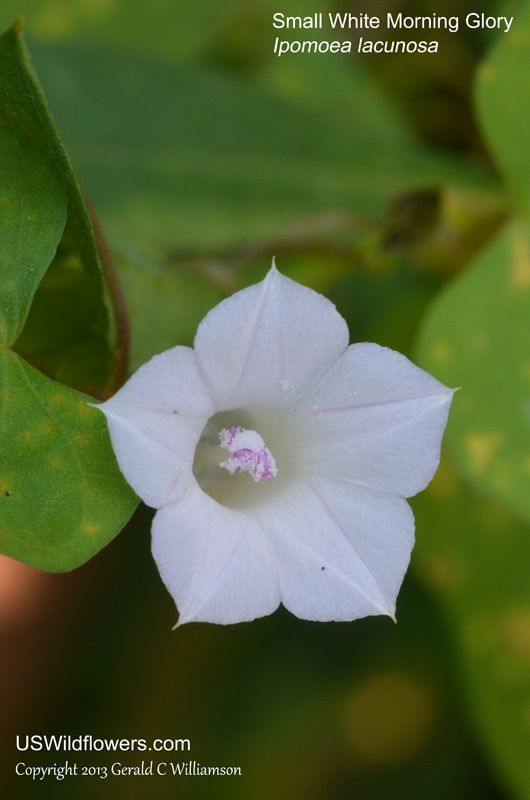
| | Site: Walker County, GA Date: 2013-September-10 | Photographer: Gerald C Williamson
Nikon D7000
Tamron SP 90MM f/2.8 AF Macro | | The inflorescence of Ipomoea lacunosa will have 1 to 3 flowers, each no more than an inch long and less than that across. The pedicel is quite short, and the peduncle is shorter than the leaf petiole, which may be sparsely hairy or glabrous. The lanceolate sepals may be somewhat hairy. | | Click on the photo for a larger image
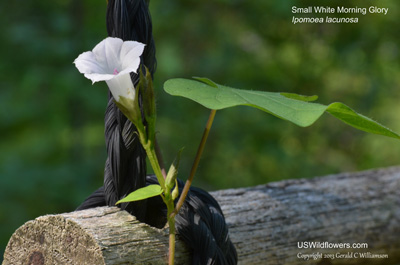
| | Site: Walker County, GA Date: 2013-September-10 | Photographer: Gerald C Williamson
Nikon D7000 | | The vine of an Ipomoea lacunosa plant twines around its support without changing the spiraling direction, usually clockwise. It is usually somewhat hairy, but may be glabrous. | | Click on the photo for a larger image
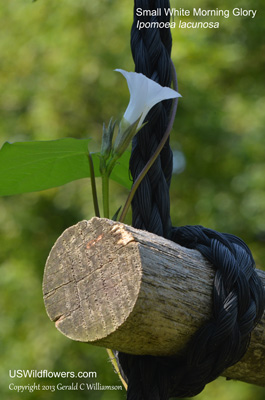
| | Site: Walker County, GA Date: 2013-September-10 | Photographer: Gerald C Williamson
Nikon D7000 | | The Ipomoea lacunosa vine, which can be up to about 10 feet long, does not have tendrils, but the end of it can look tendril-like in its clockwise spiral as it seeks something on which to climb. | | Click on the photo for a larger image
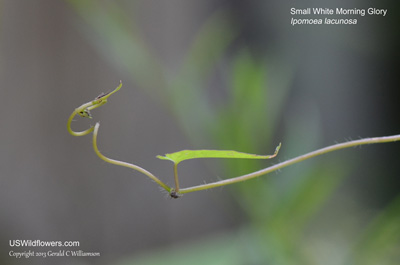
| | Site: Walker County, GA Date: 2013-September-10 | Photographer: Gerald C Williamson
Nikon D7000 | | The heart-shaped leaves of Ipomoea lacunosa are usually crimson-edged. | | Click on the photo for a larger image
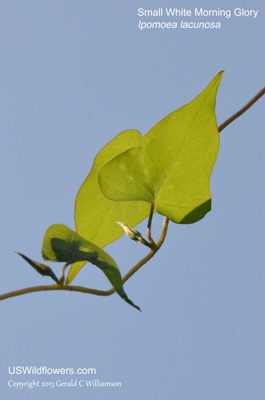
| | Site: Walker County, GA Date: 2013-September-10 | Photographer: Gerald C Williamson
Nikon D7000 | | The leaves of Ipomoea lacunosa frequently have two small lobes at the base. | | Click on the photo for a larger image
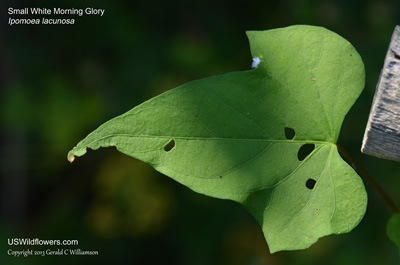
| | Site: Walker County, GA Date: 2013-September-10 | Photographer: Gerald C Williamson
Nikon D7000 | | Ipomoea lacunosa seed capsule. | | Click on the photo for a larger image
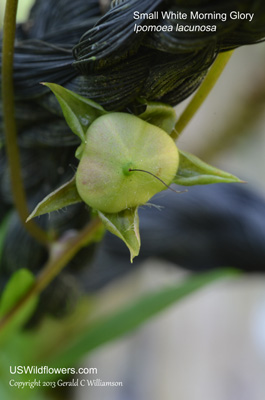
|
References used for identification and information:
|
|
| |
| #ad
|
|









